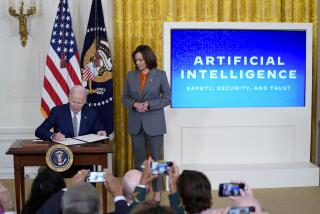What Price Intellectual Capital?
- Share via
Whether they realize it or not, millions of Americans have intellectual capital on their minds these days. Haven’t heard of it? It’s the reason Microsoft Corp. is one of the most valuable companies in the world, and why anticipation of the Windows 95 software program has driven the company’s stock to nearly $100 per share.
It’s why Southwest Airlines is so highly valued, and why Intel’s stock barely broke stride in the face of the Pentium flap. And it certainly played a hidden role in the hysteria over Netscape Communications Corp., a company with $17 million in revenue that, at one point on the day of its initial public offering, had a market value of more than $3 billion.
The worth of these companies lies not in the bricks and mortar, or the inventories, or anything else that’s normally found on the asset side of a balance sheet. Rather, it comes from an intangible kind of asset: intellectual capital. And many in the investment world are coming to believe that we must find a better way of valuing such assets, lest large investors with teams of analysts gain a permanent edge over small investors using only official accounting documents.
Steven M.H. Wallman, commissioner of the Securities and Exchange Commission, includes in his definition of intellectual capital not just human brainpower but also brand names and trademarks--even assets booked at historic costs that now are meaningless, such as a forest bought a century ago that is now prime real estate. One estimate says these intellectual assets are often worth three or four times a company’s tangible book value.
Intellectual capital has become one of the trendier topics these days among accountants, business academics and investors. Last October, Fortune magazine ran a cover story on the subject, describing the pioneering work of people such as Leif Edvinsson, director of intellectual capital at Sweden’s Skandia insurance and the creator of the first annual report on intellectual capital. The magazine noted that a number of firms, from Dow Chemical to Hughes Aircraft, were following Skandia’s lead and that several international accounting boards were also looking into the topic.
Says venture capitalist and business writer Bill Davidow: “There’s a need to move to a new level in accounting, one that measures a company’s momentum in terms of market position, customer loyalty, quality, etc. By not valuing these things, we are misstating the value of a company as badly as if we were making mistakes in addition.”
According to H. Thomas Johnson, professor of business administration at Portland (Ore.) State University, intellectual capital is related to the traditional accounting entry known as goodwill: Both seek to identify the root causes of the difference between a company’s book value and its market value. But unlike goodwill, which narrowly emphasizes unusual but real assets such as patents and trademarks, intellectual capital looks far beyond that to more ineffable assets such as the ability of a company to learn and adapt.
Intriguing as intellectual capital and “value” accounting might be, though, getting from theory to practice will be difficult, maybe even impossible. How do you place an exact value on creativity or loyalty? And how would you protect the market from abuse and companies from litigation?
Robert G. Herwick, president of Herwick Capital Management, has been on both sides of the fence, as an analyst and now as head of an investment fund. He says he can appreciate the need for firms to display and small investors to understand all dimensions of a company’s worth. But he adds, “My ability to make informed projections is my competitive advantage.”
He also worries that formalizing value accounting would create new avenues for abuse. He doubts, for example, that any company would make projections about future intangibles unless they were legally “held harmless and blameless.” But that would in turn open the door to wild and patently false predictions.
Davidow also fears the scenario of “a company president standing up to announce that ‘the company factory has burned down, we’ve lost all of our significant customers, but thanks to an as-yet-unproven scientific breakthrough, we are today announcing major profits.’ ”
But Wallman believes it can be done: “What seems clear to me is that [an accounting entry of] zero is the wrong answer. So the question is, how do you appropriately report intellectual capital?”
Wallman admits to sharing the others’ fears. Not only is there the danger of fraud surrounding the measurement of intellectual capital, but there’s also the risk that honest companies will produce these numbers in good faith and then be sued for misrepresentation when the predictions don’t pan out.
At the same time, Wallman says, “disclosure is good for everybody because it reduces risk--and that makes the cost of capital lower for companies, lowers the returns demanded by investors and in turn benefits everyone else, from employees to suppliers.”
Ultimately it may take new congressional statutes to set boundaries for the reporting of intellectual capital--and legal protections for companies willing to make such reports.
In the meantime, Wallman believes the SEC “has the ability to create some of those safe harbors non-statutorily” by establishing standards, guidelines and disclaimers. It will be precisely those “safe harbors”--value accounting, the meaning of intellectual capital and the impact of technology on all of this--that will be the subject of an SEC-sponsored conference later this year.
More to Read
Inside the business of entertainment
The Wide Shot brings you news, analysis and insights on everything from streaming wars to production — and what it all means for the future.
You may occasionally receive promotional content from the Los Angeles Times.










